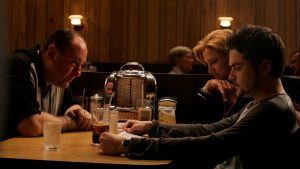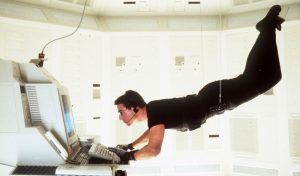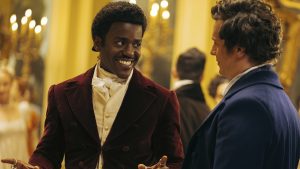
Twenty years ago, Spider-Man 2 boiled down the basic appeal of the Web-Head in movie form. Peter Parker is the guy for whom wearing a mask and fighting crime is a noble duty, sure, but it’s also sometimes just a job—one complete with busy work, tedium, and 99 problems that distract from the other important things in life. In Peter’s case that’s studying for midterms, hanging out with his best buddy Harry Osborn, and, dare he dream, making it to Mary Jane Watson’s play on time.
In the two decades since the movie’s release, there have been plenty of other Spider-Man pictures. Some have been good, some amazing (looking at you Spider-Verse!), and more than a few that left you wanting. None of them though have been able to so succinctly tap into the appeal of those earliest comic book runs that defined the character like Spider-Man 2. There’s a reason that the image of Peter Parker leaving his costume in a back alley trash can in Amazing Spider-Man #50 (an iconography courtesy of the late great John Romita Sr.) is now an indelible movie moment.
Much of this is a credit to director Sam Raimi, a definite visual stylist in his own right that has a deep appreciation for cinematic language. He also had a lot of childhood nostalgia for those early Stan Lee and Romita runs, or the one with Lee and artist Steve Ditko before that. And the trick about the Raimi films is he chased the appeal of those first Friendly Neighborhood stories with his own specific cadence in visual storytelling. The digital effects might age, and some of the composite shots might look quaint when compared to what Marvel Studios produces these days (albeit not always), yet the visual dynamism of Raimi’s blocking and camera movements, and the emotional heart he imbued in those scenes, still pop.
Strangely enough, this might be best represented by a scene without Spidey at all. In fact, it comes from the best villain introduction we’ve had in a movie featuring the webslinger. We’re of course talking about Doctor Octopus.
When developing Spider-Man 2, the clear assumption was always for Doc Ock to be the villain. He had featured in various versions of the first Spider-Man’s screenplay, including the drafts penned by the only credited writer on the film, David Koepp. Yet Raimi and company eventually made the wise decision to simply feature one villain in that film: Willem Dafoe’s Green Goblin.
Dafoe certainly turned in an unforgettable performance too. It was a chance for one of the more eccentric character actors of his generation to let his freak flag fly in a family-friendly entertainment. However, the entire depiction of the Goblin in that film was hampered a bit by the context it was made in, be it as a superhero movie developed during the tail-end of the ‘90s; as a character intended to sell action figures; and as the antagonist in a film that would mostly be about how Tobey Maguire’s Peter Parker came to the conclusion he should spend his life in red and blue tights.
Dafoe deserves a lot of credit for making that costume and unmovable mask work, but there was obviously room for improvement—something that would come when Doctor Octopus crashed his way onto the scene in Spider-Man 2.
As largely defined by screenwriters Michael Chabon and Alvin Sargent, Otto Octavius is a quite human character despite the absurdity of his appearance—something the script is also aware of considering it features lines like this: “A guy named Otto Octavius has four mechanical arms welded right onto his body. What are the odds?” But while Raimi was never one to miss a chance to smirk at the audience, he and the writers played Ock completely straight—and Alfred Molina did them one better; he underplayed the material.
In the comics, Doc Ock is a terrific silver age baddie and always considered in the running for Spidey’s greatest foe—usually against the likes of the Green Goblin and Venom. But also like many a villain created in ‘60s comics, he’s playing to the back row. He’s a classic megalomaniac who likes to monologue about his plans to rule the world. It’s great stuff for a comic book or cartoon show, but it was always something that could come off as goofy as… well, Dafoe in that green suit.
And yet, in Spider-Man 2 Doc Ock is as cold and smooth as his metallic, gliding limbs. These mechanical vipers were created by an impressive combination of CGI and practical puppeteering courtesy of special effects house Edge FX. We might even point out the mingling of digital effects and practical animatronics cause the villain’s appearance to look better 20 years on than the entire CG look embraced by Marvel Studios when they brought Otto back in Spider-Man: No Way Home.
Doc Ock circa 2004 is indeed a visual marvel, with his sinewy “tentacles” climbing around the architecture of New York City like a quartet of serpents drifting beneath the surface of a river. But the reason the character is still so impressive in the annals of superhero movies isn’t because of visual effects; it’s due to how they’re used.
The aforementioned script combines elements of Dr. Octopus’ megalomania in the comics with the more sympathetic backstory of the Lizard (a Jekyll/Hyde inspired family man whose fate acts as a cautionary tale for Peter Parker). Screenwriter Alvin Sargent—who won Oscars for Julia and Ordinary People well before he worked on Raimi’s Spidey trilogy—and Molina use that background to instill genuine warmth and humanity to Octavius. And despite the winks they might have about his name, whenever Otto’s onscreen the absurdity of the situation is minimized by a performance from Molina that’s wholly earnest and rife with melodramatic conviction.
All of which makes the scenes where Doc Ock goes truly evil all the more thrilling. We mentioned earlier Raimi’s visual dexterity, and it’s a gift that was never more mischievous or sinister in his Spidey tryptic than in the scene where Otto becomes Ock; the scene where Doctor Octopus turns into a veritable Evil Dead demon on an ER floor’s worth of surgeons.
Scenes of monsters killing nameless doctors is of course nothing new. There’s something a bit Frankenstein about the scenario—or perhaps Independence Day was the point of reference when the scene was written in the early 2000s. Either way, a room of physicians are taken out by the creature they’re there to study. The reasons are a bit goofy–something to do with an “inhibitor chip” on Otto’s spine being fried in a lab accident. Hence why the medical staff is so intent on cutting the arms out of his back.
It’s murky like a comic book, but the point is when the chief surgeon fires up a bone saw and chuckles, “Anybody here take shop class?” those metal monstrosities are going to defend themselves in a way Raimi could imagine. In a sequence that intentionally harkens back to Raimi’s B-movie roots on films like The Evil Dead (1981) and Evil Dead II (1987), the unusually under-lit and shadowy operating room is invaded by steely appendages, created via practical and digital effects, that leave a shocking body count in their wake.
MDs are thrown through windows; they’re driven with their scalpels into electric lights where they’re zapped to death; one even has her nails fall off as she is dragged screaming across the tile floor, leaving inch-deep marks in her wake. As is Raimi’s wont, the scene is both macabre and darkly amusing. There is no reality to those deep scratch indentations, or the high-contrast lighting which Raimi juxtaposes with heavily canted Dutch angles and extreme close-ups. There’s a palpable mean-spiritedness to it that made Evil Dead such a gas. Notably, Spider-Man 2 is even edited by Bob Murawski, Raimi’s cutter on the Evil Dead comedy threequel, Army of Darkness (and also future Oscar-winner for The Hurt Locker).
The hospital scene of Spider-Man 2 takes on the same breathless rhythms of the Evil Dead sequels, complete with a cheeky visual reference when one surgeon unsuccessfully attempts to defend himself with a bone saw that looks suspiciously like Bruce Campbell’s chainsaw of choice. Raimi also includes a winking cameo to one of his mentors, John Landis, who plays a doctor whose spine is obliterated by one of Ock’s arms. It’s funny, but the laughs are of a peculiar and perverse sensibility that most kids wouldn’t pick up on. As a set piece for the movie’s target audience, it’s intense, shocking, and faintly scary.
Superhero movies could use more of that energy. This was reinforced a few years ago when Raimi returned to the genre for the first time in decades via Doctor Strange in the Multiverse of Madness—a film with an entirely unremarkable Marvel Studios screenplay (which is to say a lot of sitcom-y character-building which strings together almost entirely blue screened action sequences). Even so, Raimi was able to lay on the kind of visual sadism and horror-lite quality that makes the hospital scene in Spider-Man 2 so memorable. Unfortunately, a number of modern fans unaccustomed to such cinematic seasoning their superhero happy meals complained it was too dark, weird, or mean to fan favorite characters like Mr. Fantastic and Charles Xavier. Even Variety pondered whether it should’ve been rated R.
Caped cinema and blockbusters as a whole could use a little more of that kind of spice. And not just in terms of scenes of superhero villainy that faintly skirts the horror genre with a spring in its step (a distinctly Raimi speciality). Rather superhero movies should embrace giving audiences more villains as entertaining, textured, and as dynamically thought out as Molina’s Ock. Each sequence was planned enough to incorporate tactile in-camera special effects, and supported by a firm screenplay that gave an actor like Molina something to work with.
Only after those concrete foundations are laid could we get something as satisfyingly bizarre as seeing Doc Ock sending the Blues Brothers director speeding into a wall at 40 MPH. It made for a better villain and a better movie. And it’s one of the reasons we’re still talking about Spider-Man 2 20 years on.
The post Spider-Man 2: We Need More Villain Scenes Like Doc Ock in That Hospital appeared first on Den of Geek.




